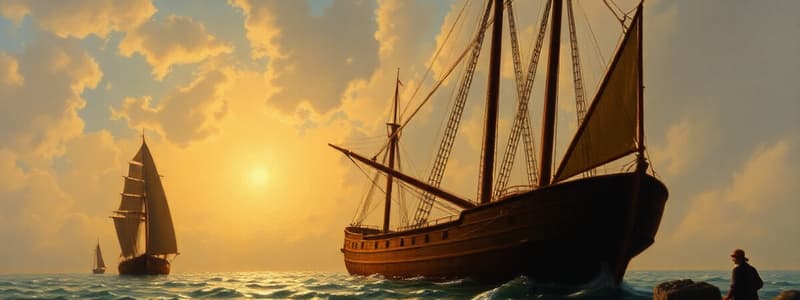Podcast
Questions and Answers
Under MC s. 151, who primarily bears the vicarious liability as a shipowner?
Under MC s. 151, who primarily bears the vicarious liability as a shipowner?
- The charterers of the ship
- The assistants on the ship
- The P&I insurer
- The shipowner (reder) (correct)
According to the content, strict liability for technical failure in maritime law has a broad and unlimited scope.
According to the content, strict liability for technical failure in maritime law has a broad and unlimited scope.
False (B)
In the context of MC s. 151, briefly explain the significance of P&I insurance.
In the context of MC s. 151, briefly explain the significance of P&I insurance.
P&I insurance provides financial protection to shipowners against various liabilities, including those arising from vicarious liability.
Torts Act s. 1-4 states that a tortfeasor must compensate damage lawfully inflicted to avert __________ __________.
Torts Act s. 1-4 states that a tortfeasor must compensate damage lawfully inflicted to avert __________ __________.
Match the legal concept with its description according to the content:
Match the legal concept with its description according to the content:
What is the primary consideration when determining liability for ship collision cases under maritime law, according to the content?
What is the primary consideration when determining liability for ship collision cases under maritime law, according to the content?
The 'servant's right of abatement' refers to the servant's right to reduce their liability in all circumstances.
The 'servant's right of abatement' refers to the servant's right to reduce their liability in all circumstances.
How might the concept of 'pre-programmed ship-conduct' play a role in determining liability for autonomous ships in emergency situations?
How might the concept of 'pre-programmed ship-conduct' play a role in determining liability for autonomous ships in emergency situations?
The content mentions the case of the Muncaster Castle (LLR 1961,1,57) as an illustration of shipowner's vicarious liability in __________.
The content mentions the case of the Muncaster Castle (LLR 1961,1,57) as an illustration of shipowner's vicarious liability in __________.
Which of the following scenarios does the law of necessity primarily address regarding liability?
Which of the following scenarios does the law of necessity primarily address regarding liability?
Flashcards
Shipowner's Vicarious Liability
Shipowner's Vicarious Liability
A shipowner's liability for the actions of their crew or employees. It is addressed in MC s. 151.
Who is 'reder'?
Who is 'reder'?
The 'reder' is the defendant in cases of shipowner's vicarious liability. The 'reder' has a relationship to charterers.
Uncertainty in scope of assignment
Uncertainty in scope of assignment
This refers to harm done beyond the scope of what the servant was assigned to or should be doing.
Strict liability for 'technical failure'
Strict liability for 'technical failure'
Signup and view all the flashcards
Maritime Law
Maritime Law
Signup and view all the flashcards
The law of necessity
The law of necessity
Signup and view all the flashcards
Torts Act s. 1-4
Torts Act s. 1-4
Signup and view all the flashcards
Study Notes
- JUS 5406 concerns different bases of liability.
MC s. 151 - Shipowner's Vicarious Liability
- Vicarious liability involves the shipowner.
- Relevant background and rationale must be considered.
- The 'reder' is the defendant, necessitating an understanding of their relationship with charterers.
- The definition of the relevant class of assistants, the 'service of the ship', and the nature of a shipowner's business and expertise is considered.
- English law offers illustrations: The Muncaster Castle (LLR 1961,1,57) in contract, and the Hopestar (LLR 1952,105) in tort.
- Uncertainty exists regarding acts of harm beyond a servant's scope of assignment.
- Sardinia (ND 1914.159) and Trygg (Alkejakt=auk hunt) (Rt 1972.815) are illustrative cases.
- Claims against assistant-tortfeasors are direct per MC s. 151,2, relating to Torts Act s. 2-3.
- Examples of direct tortfeasor claims include a servant causing harm to a principal's property, or a principal being held liable towards a claimant and claiming recourse against a servant.
- A servant held liable towards claimant grants claims of recourse against a principal, equalling the servant's right of abatement in all constellations.
- P&I insurance has practical significance.
- MC s. 151 is significant in modern shipping contexts such as autonomous ships.
Strict Liability for 'Technical Failure'
- This concerns background and rationale.
- The scope is limited in maritime law.
- Examples include Neptun (ND 1921.401) and Sokrates (ND 1952.320), with consideration of Uthaug (ND 1973.348) and Ladogales (ND 1969.381).
- Maritime law has peculiarities in ship collision cases.
- Marna Hepsø (ND 1971.36) is a key case.
- Supreme Court maritime law is dominated by fault-based rules and international conventions, but without elaboration in Uthaug (ND 1973.348).
- 'Technical failure' has significance in modern shipping.
Law of Necessity - Strict Liability
- This concerns background and rationale.
- Torts Act s. 1-4 states a tortfeasor must compensate for damage lawfully inflicted to avert threatening danger.
- There are diverse international positions across Nordic, English, German, French, and American law.
- The practical significance is perhaps limited, but there are still Supreme Court cases.
- Liability exists for damage to submerged cables, see Consul Bratt (Rt 1955.872) and Proteus (Rt 1925.808).
- No liability exists for damage to a quay: Sirius (Rt 1948.1044) and Sokrates (Rt 1952.1170).
- No liability exists for collision in emergency anchoring: Kong Sigurd (Rt 1955.1055).
- there is liability for collision in emergency anchoring, see Bergen City Court: Koløy-holmen (ND 1949.709).
- There is a potential role in autonomous ships and damage in emergency through 'pre-programmed ship-conduct'.
Studying That Suits You
Use AI to generate personalized quizzes and flashcards to suit your learning preferences.




